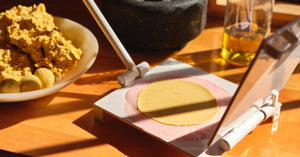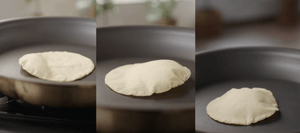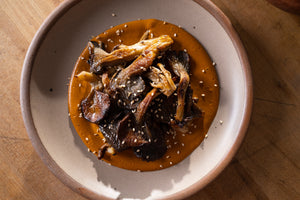Masa Feature : Red Cónico (Estado de México)
Masa Feature : Red Cónico (Estado de México)

May 8, 2020
Welcome back to another installment of Masa Feature, friends! We're back at it with fellow masaphile and puff commander, Justin Crawford. Justin is a home cook performing masa miracles using a hand-cranked mill (that’s right, no Molinito required).
This week, we remotely tag-teamed Red Cónico, grown by our longtime partner Don Armando. Fun, true story: Don Armando hosted Grammy award-winning singer Miguel and me at his home for a special series called Earthworks produced by Vice. Check it out here. FWIW, I remain a life-long Miguel fan to this day.
In order to provide some nuance for approaching the same varietal, Justin and I assumed slightly different angles for the red cónico—from cook times, to grinding method to final dishes. Spoiler alert: My tortilla does not get a puff on this batch. You'll just have to see why at the very end.
Our preparation notes, from kernel to finished tortilla, are below, with hyperlinks to each chapter of our Kernel-to-Masa series on Masienda's YouTube channel, making it easy to follow along with our go-to instructions for preparing any varietal.
And if you you're not feeling ready to jump into making masa from dry corn, you can EASILY replicate these dishes with our Heirloom Corn Masa Harina.
Feel free to post any questions or comments below!
Pre-Cook:
This lot of red cónico was grown by one of our very first partner farmers, Don Armando. He is located about two hours outside of Mexico City, near Atlacomulco. Elotes cónicos, especially the blue varieties that are endemic to the state, have long been coveted for their application to table tortillas and tlacoyos throughout the region.
Masienda’s partner grower, Armando, maintains a 5 hectare milpa that has been in his family for five generations (which is as far back as he can personally trace). The red is not as commonly grown as the blue, but Armando can’t speak highly enough of this kernel’s flavor and texture for his tortillas at home. His word of choice to describe them: "sabrosisísimo".
Justin: Absolutely beautiful color like good red wine. It reminded me to drink a little. End goal for this batch was tortillas for tacos and tostadas.
Jorge: This being a super soft starch--like, the softest, flouriest we've found that still makes an excellent tortilla and doesn't fall apart--I wanted to play with texture contrasts in my absolute favorite application, a tlacoyo. A tlacoyo is essentially a masa pocket (cue the "Hot Pocket" jingle) that has the best of both worlds: a chewy, crispy crust and a molten, gooey center. The crisping occurs because they spend a good deal of time cooking directly on the comal/plancha/griddle/pan (henceforth "griddle"), in order to heat through the center. The molten-ness is made possible by the filling, in this case Masienda heirloom black bean puree, as well as the moist, though not raw, masa itself that steams in the center.
NOTE: Though I played with the finished masa a bit in a tortilla application, tortillas were not our end goal, here. That said, we actually learned a few things about this cónico varietal that may help other folks at home if you are making tortillas, and what to avoid if you are chasing that table tortilla puff.
Justin: Added 250 grams of corn + Cal (2.25 grams = 0.9%) + water (500 grams = 200%) in a copper pot. It came quickly to a boil. Then reduced heat to keep at a low simmer for 42 minutes then cut off the heat. Pronounced earthy honey funky aroma. The soup became very dark, and the tips even remained dark during cook. Very moody looking corn.
Jorge: Cooking at the office again using an induction burner with an enamel-covered steel stock pot. Just under 1% cal ratio (0.88% to be exact) for 5 lbs of corn (0.71 oz of cal total) with enough water to cover about 3-4 inches above the corn. I used slightly less than 1% cal in order to preserve as much of the natural red color of the corn as possible. Cal has a yellow tint when activated with water, and the more cal that you use, the more it alters the corn's natural pigmentation. Red corn will yield brown masa, for example, blue corn will yield a greenish masa, white corn will yield a yellowish masa, etc.
Obviously, if you use too little cal, you're not going to achieve proper nixtamalization later on. A dead giveaway of this is when the skins do not easily rub off in between your fingers into a sticky, slick kind of pulp--instead, they'll stay stuck to the kernel, becoming slightly transparent and will difficult to peel off. I don't have the exact percentage for you on how low is too low (I'll play with it over the next few weeks and get back to you, though I know it will depend on each varietal), but I can say with confidence that: 1) 1% cal is consistently ideal with any variety of corn you use and 2) the right amount of cal (again, 1% is the sweet spot) will complement and turbocharge the corn flavor by several notches, in the best way possible.
I brought the corn and cal water up to a boil on high heat, which took 20 minutes because I kept removing the lid to check on if the water was boiling (it probably would have been 15-17 min had I not removed the lid so many times). I then removed the lid and dropped heat to medium heat (190-198 F) for the remainder of the cook of about 10 minutes. By the end of 30 minutes total, I shut the heat off.
Cónico can be a tricky cook. For any other varietal we offer and work with, you can almost always count on this sequence to occur during cooking: first you'll achieve a loosening of the skins and a few minutes later, you'll reach an ideal al dente bite and fully bloomed flavor. Because it's so soft of a kernel, though, cónico may often become al dente in texture before the skins are fully loosened, which means that you may overcook it, if you're expecting the usual order of skins loosening followed by flavor and texture developing. For this reason, I use a gentler cook once the water has heated up so that the corn doesn't get hammered while I wait for the skins to loosen sufficiently.
Nixtamalization:
Justin: 12-hour steep
Jorge: 16-hour steep with the lid on. It's amazing how much the soaking process (using residual heat) gives the cónico a bit of an extra cook (unlike our bolita last week, which is much tougher and denser of a starch). It's more sensitive to heat than other varietals, so be sure you're not overcooking the cónico when the heat is turned on, because the residual heat in the soak will make the cónico about 10% softer. If you want to prevent additional cooking, you can always shock the pot with ice, which will drop the temperature immediately.
Nixtamal Rinse:
Justin: Proceeded with a relatively rustic method. Cooking pot topped up with cold water, kernels gently massaged, water strained off the top, process repeated one more time with even gentler massage. Estimated 50% washoff? Drained. Final weight of pre-grind corn = 436 grams.
Jorge: I've been recipe testing recently with 100% washoff and continued this trend with the red cónico. I wasn't prioritizing a table tortilla in this scenario and wanted as clean of a color and bite as possible for the tlacoyo. The skins were very dark (pictured below), which you can definitely imagine would have given a brownish hue to the finished masa. The rinse is a step in the process with big implications, as we'll see later on...
Nixtamal Grind:
Justin: I used an Estrella manual grinder. Three passes total. Hydrated with 30% of original weight of corn through the process of grinding (75 grams). Hydrated to touch to make press-ready. Final yield = 425 grams. Note: 65 grams of loss due to masa in auger well at the end. Same method as Bolita. Made for a much more cohesive masa with almost bouncy ball resiliency. Earthy, silo aroma. Almost like hay and other dry things. In a great way.
Jorge: Molinito grinder. Like last week, a very fast grind (maybe 3-4 minutes total) due to there being no skins left on the nixtamal (which helps speed things up). A hair coarser than a fine table tortilla masa--smooth texture overall with soft bits of the dark red endosperm visible and only very slightly detectible when I rubbed the masa between my fingers.
Talcoyos with too fine of a masa grind will start to puff, like a tortilla would (similarly, after the second flip). This is delicious and fun to watch, but can be messy, especially if a seam opens, mid puff, exposing the filing which can start to splatter out. I like a slightly coarser of a grind for this reason, to keep puffing to a minimum, but aerated enough that it's still light and cooking through the center.
Masa Mixing:
Justin: Kitchen Aid with paddle attachment for 5 minutes.
Jorge: Although tlacoyos will traditionally get a bit of lard folded in, I wanted to see how the masa held up on its own. And, honestly, I really didn't want to wait in line for 30 minutes with a mask on just to get into the supermarket or bodega for lard. Mixed using the paddle attachment on KitchenAid for 5 minutes, adding a good deal of water, slowly of course, until the masa wasn't cracking anymore (when flattened in my hand for a quick sample test). The masa was ready just before that point where it would have stuck to my hands, which is to say that it was wet but not sticky.
I did have to shut the mixer off every 20 seconds or so to push masa back to center of the bowl before restarting. I had a pretty full mixing bowl, so it makes using the paddle a bit harder than a hook. If I'd had more time, I would have broken up the masa into several batches and mixed each batch to the right texture and moisture.
No salt added, though I wouldn't have minded a hint of salt (maybe 0.15% or so, compared to the weight of the masa itself).
Masa Press and Tortilla Cook:
Justin: Doña Rosa x Masienda tortilla press. Felt awesome in the press as it offers a lot of resistance and formed perfect circles with little help. You could almost stand on the press and have a nice round come out.
Eyeballed the weight for these as I was going with a more freewheeling approach. Same method as last week for the taco tortillas. Got a good puff here as well with edges sometimes not wanting to give way to the steam. Started to spritz portioned dough in hand a little prior to forming and that did the trick.
TOSTADA COOK: Slightly thicker and more irregularly sized rounds for the tostada-bound tortillas. These were not allowed to puff as I wanted a thicker, crunchier round that would stand up to wet ingredients without becoming soggy. Tostadas cooked on clay comal over medium heat until completely crisp and brown in spots. Left to cool completely.
Tostadas served under smashed black beans, chicken tinga and lime crema with beer.
Jorge:
TLACOYO: There are so many methods for shaping a tlacoyo into its traditional-looking football shape, but at the end of the day, it's entirely up to you as to how you get there. Many pros in Mexico can do it entirely by hand while others may use a tortilla press so expertly that they can flatten the filled masa into perfect, oval-shaped submission. I am particularly inept at shaping most doughs, and the lack of skins/pericarp in my masa made the masa a bit more tricky to work with. (Remember, the skins are where all the natural gums of the corn are--they're what give the masa a bounce and elasticity.)
So, I did a hybrid press and fold approach. Shout out to masa comrade chef Fermín at Suerte who, coincidentally, also made tlacoyos this week using the same kind of improvised method. It clearly gets the job done well, no matter what your level of experience is. Photos below of each step of the folding process, which is pretty straightforward visually, but let me know if you have any questions, if not!
Once folded, I slightly flattened the seams enough to ensure that they wouldn't burst open during the cook, but not too much because I kinda like the complexity of texture that they add.
I put them seam side up (i.e., opposite, smooth side down) on an electric griddle on high heat, no fat or oil. I wasn't timing the cook of each one but I'd guess they took around 12 (?) minutes total. I first seared each side to the point that they each started developing light char marks (about 4 minutes per side). Once both sides were seared, I flipped them back and forth every minute or so until they were cooked through the center. You can test for doneness with a cake tester, if you'd like, but I just tested by feel, looking for a dense exterior that, when pressed down, didn't give or bounce much--like a well-done steak might, for example. I did have a tiny bit of chicken fat that I drizzled onto a few tlacoyos, for some extra flavor. Schmaltz is not traditional in tlacoyos but damn, so tasty.
This being executed from our office kitchenette (with a tiny fridge and improvised garnishes), I finished with a bit of queso fresco we had left from last week and our go-to office condiment/salsa substitute, Yellowbird. Again, not necessarily traditional, but we use whats we gots in order to make delicious happen. The finished bite had a chewy, crusty, molten mouthfeel. Disco.
TORTILLA: As expected, the red cónico made for an excellent tortilla--grassy, earthy, soft, delicious. But, are you ready for the kicker? It didn't puff!
Despite prioritizing a tlacoyo application, I still had expectations that we'd get a tortilla, made with the same tlacoyo masa, to puff. I've gotten a nice puff on the red cónico plenty of times and knew it was possible. So, what gives? Disclaimer: We're going to get real nerdy, here, friends, but alas, science does make sense of it all.
There are four characteristics we often cite when it comes to achieving a tortilla puff:
- A fine grind
- Ample moisture
- The right amount of compression when pressing the tortilla
- A very hot cooking surface (400 F is on the low side, but this can still eek out a mild puff)
All of these conditions were met, which totally stumped me at first. I even spent a few hours playing with all of the variables, adjusting to various extremes: I used both our electric griddle (390-400 F) and a 500 F cast-iron pan (over gas flame), I tested a range of thicknesses of tortilla (from super thin to thicker, almost memela-thick tortillas), and I played with various moisture levels. None of these made a difference.
To say I was frustrated, by this point, would be an understatement.
It wasn't until I went back to the uncooked kernel that I figured out what the culprit was. If you'll recall, the cónico starch is a very floury kernel with very little hard starch. Just break a kernel open with your back teeth and you'll see immediately what I'm talking about--it's almost all white inside (which is the soft starch/soft endosperm). The soft starch makes for a very soft tortilla, which is something we love about this corn, but that starch alone is not sufficient to making an elastic, bubble-gum-like puff.
In addition to the skins--which, when activated during nixtamalization, are where all of the corn's natural gums are--the hard starch (or horneous endosperm) and germ are where a majority of the emulsifying agents like protein and oils are located in the corn. We take them for granted because they are very present in most other masa-driven varietals in the world, but when they're less involved in the corn's composition, you really begin to understand how instrumental they are in balancing the masa's overall structure.
And in my case, not only were we going into the kernel-to-masa process with a varietal whose ratios leaned more heavily toward flour than proteins and oils, but I also ultimately washed off all its skins--the last bridge to a powerful puff. The skins would have balanced the masa enough to get the elasticity we needed for liftoff. There's even something to be said about the reduced amount of cal, which also acts as a bridge between the starch and emulsifying agents, but, as Justin demonstrated, it was still sufficient at around 0.9% to get the job done.
Moral of the story, don't forget that every varietal has its quirks. Embrace this diversity thoughtfully. It tastes delicious.
Bonus: I added a very light dusting of cal to a bit of the masa to show just how much the increase in pH caused by the cal can affect the color of the masa. The darker version is with the cal that I added directly to the masa.
-Jorge


